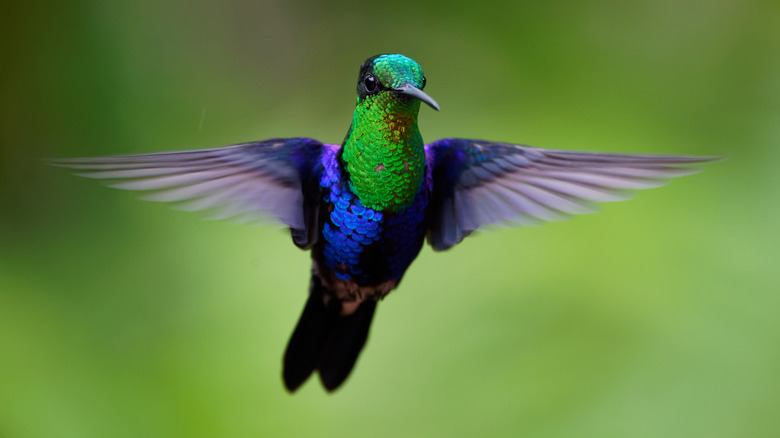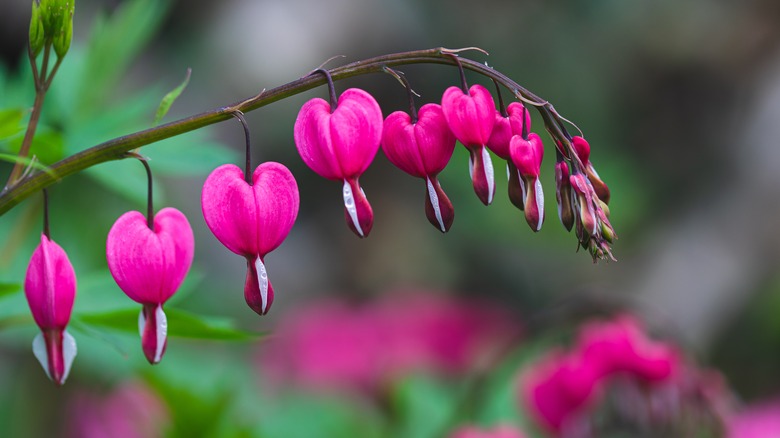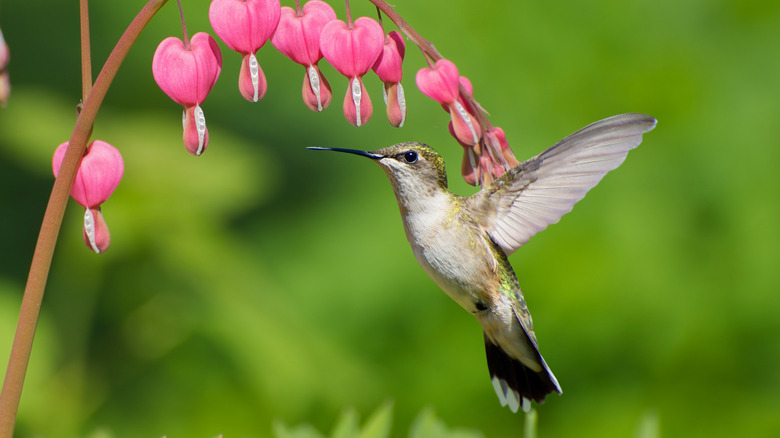The Romantic Sounding Flower That Will Entice Hummingbirds To Your Garden
Hummingbirds are fascinating creatures. They weigh less than two pennies and beat their wings up to 80 times per second. They only exist in Central and North America, so if you're lucky enough to live in their range, take the opportunity to lure these magical birds to your yard. Bleeding hearts (Dicentra spectabilis) are an eye-catching lure for hummingbirds as well as a lovely complement to flower beds. These unique plants are among the top flowers that hummingbirds love.
The pendulous heart-shaped perennials appear in spring and set the stage for a hummingbird feeding frenzy that can last for months. Interplanted with other flowers, bleeding hearts kick off the growing season and can make your yard a popular hummingbird hangout for the rest of the summer and early fall. With their fairy-like flight patterns, hummingbirds offer hours of enjoyment and pollinate your garden like champs.
How to grow bleeding hearts
With such a name and appearance, you may think bleeding hearts to be delicate and difficult to grow. On the contrary, this hardy perennial can thrive in USDA zones 2 to 9 if you provide the right conditions. Bleeding hearts can reach heights up to 2 feet, with branches arching as long as 3 feet. They prefer partial shade, cool temperatures, and moist soil. Dicentra spectabilis bloom from April to May and grow from a tuber that is best planted in the fall before your area's first frost. You can also find established bleeding hearts in containers at nurseries, and they can be planted directly in your garden after the area's last frost. Consult the Old Farmer's Almanac guide for frost dates to help with your timing.
Prepare your soil for planting by loosening the earth up to 1 foot deep and adding compost. Plant the tubers 1 inch deep, and space them about 2 feet apart. Lightly tamp the soil over the tubers, water thoroughly, and top with mulch to help seal in moisture. Care for your bleeding hearts with weekly watering. Don't allow the soil to dry completely.
Plant bleeding hearts with other blooms hummers love
A patch of early-blooming bleeding hearts inaugurates your growing season by enticing hummingbirds to your garden. However, they don't bloom too far into the hot season. Let bleeding hearts provide the initial bait for birds, but you can attract more hummingbirds to your garden and prolong their stay by adding additional plants that will keep them around until they migrate.
Consider the flowers' shapes and especially their colors when planning your hummingbird habitat. Long, tubular flowers in vibrant reds, pinks, and purples are a magnet for hummingbirds. Yellow and orange flowers are also tempting to them. Intermixing blooms that flower at staggered times throughout the season are great for keeping hummingbirds around until they migrate. Columbine, salvia, rhododendron, and trumpet vine emerge in mid-summer and often maintain blossoms until fall.
If you live in a hot, dry climate, bleeding hearts traditionally don't do well in these conditions. However, don't despair: there are newly engineered variants, such as the cherry-colored 'Valentine' and vibrant red 'King of Hearts', that are more heat- and drought-tolerant. Dicentra spectabilis are also deer-resistant, making them worth their time and financial investment. You can even encourage a second bloom by deadheading the flowers or making cuttings.


